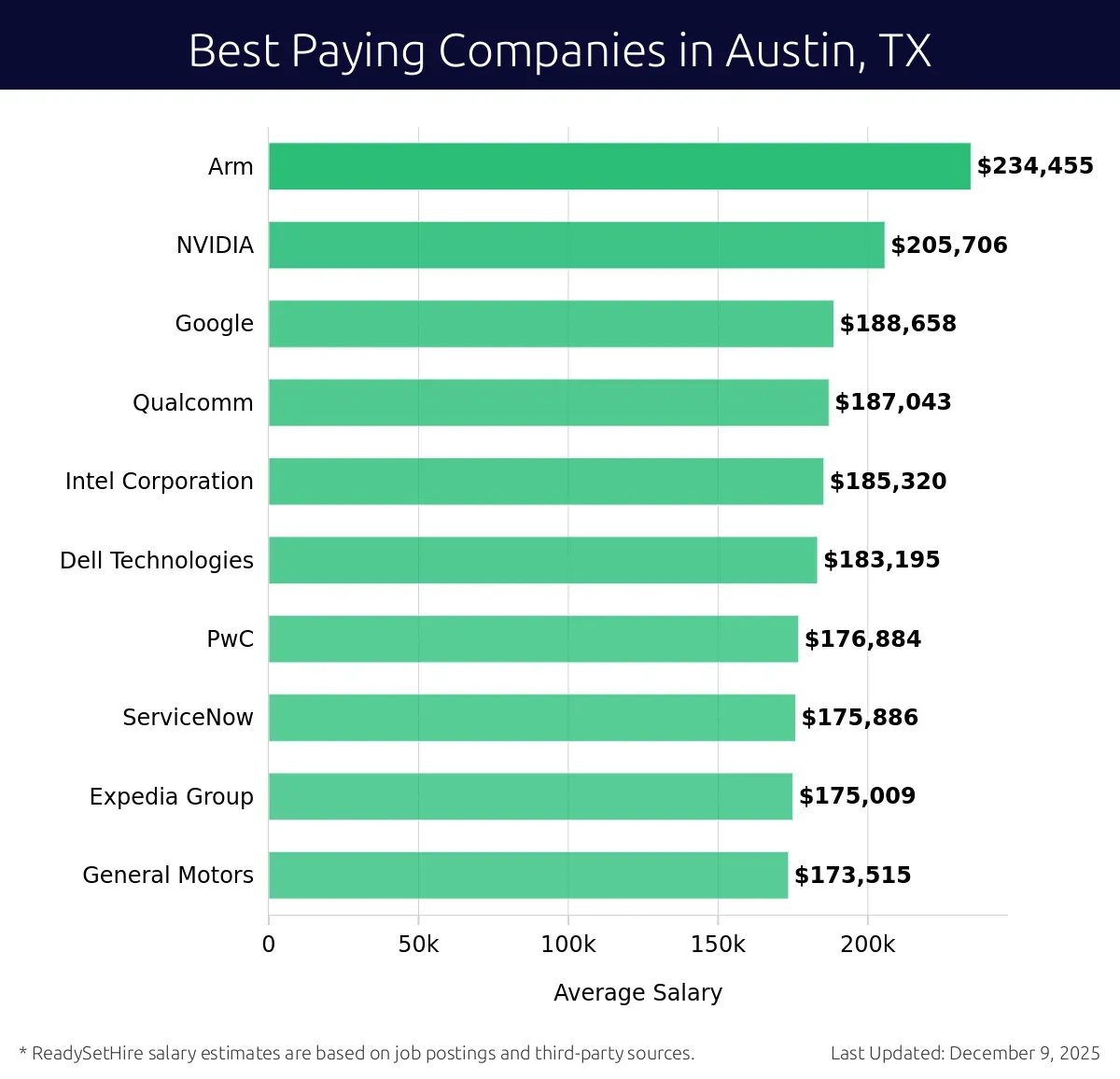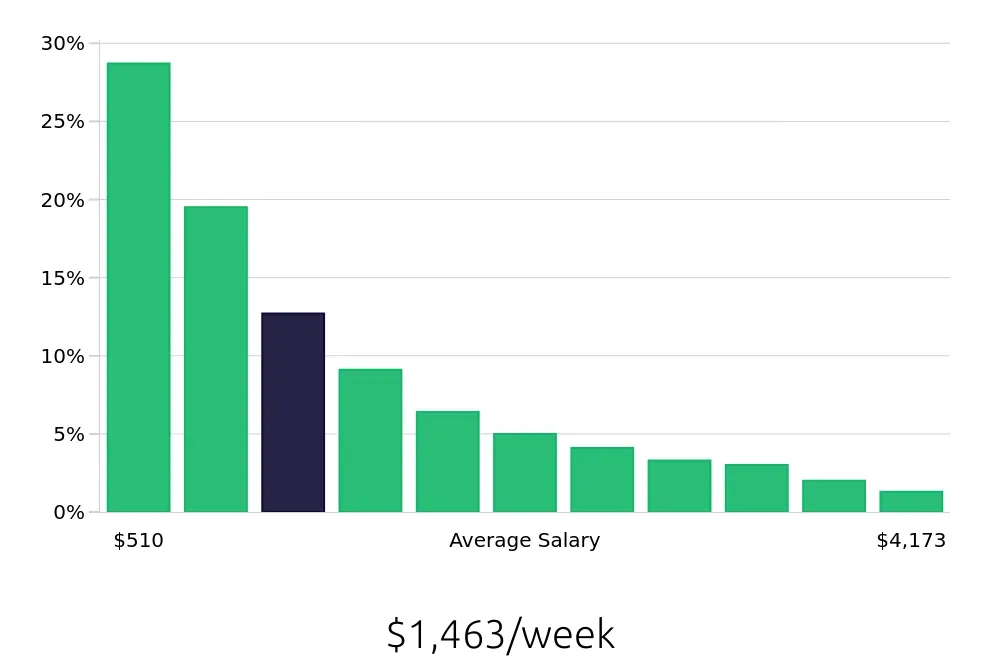What is the average salary in Austin, TX?
Austin, TX, offers a range of salary opportunities across various industries. The average yearly salary in Austin is $76,081. This figure reflects the diverse job market and the potential for competitive compensation. Job seekers can find roles that match their skills and experience, with salaries varying based on the industry and position.
Some of the top-paying industries in Austin include:
- Information Technology: $113,091
- Healthcare: $95,773
- Finance: $87,455
- Engineering: $78,455
- Education: $61,136
These figures highlight the potential for higher earnings in certain sectors, making Austin an attractive location for professionals seeking better pay.
What are the best paying jobs in Austin, TX?

-
Psychiatrist
Average Salary: $349,199
Psychiatrists diagnose and treat mental health issues. They work in hospitals, clinics, and private practices. Austin has many opportunities in this field.
Find Psychiatrist jobs in Austin, TX
-
Certified Registered Nurse Anesthetist
Average Salary: $298,403
These professionals administer anesthesia. They work in hospitals and surgical centers. Austin offers a variety of positions in this field.
Find Certified Registered Nurse Anesthetist jobs in Austin, TX
-
Owner Operator
Average Salary: $286,363
Owner operators manage their own businesses. They work in various industries, including trucking and small businesses. Austin has a growing market for these entrepreneurs.
Find Owner Operator jobs in Austin, TX
-
General Dentist
Average Salary: $265,131
General dentists provide routine dental care. They work in private practices and clinics. Austin has many opportunities for dental professionals.
Find General Dentist jobs in Austin, TX
-
Physician
Average Salary: $249,094
Physicians diagnose and treat illnesses. They work in hospitals, clinics, and private practices. Austin offers a variety of positions for medical doctors.
Find Physician jobs in Austin, TX
-
Principal Engineer
Average Salary: $205,725
Principal engineers lead engineering teams. They work in tech companies and startups. Austin has many opportunities for experienced engineers.
Find Principal Engineer jobs in Austin, TX
-
Technical Architect
Average Salary: $175,565
Technical architects design systems and software. They work in tech companies and consulting firms. Austin has a growing demand for skilled architects.
Find Technical Architect jobs in Austin, TX
-
General Counsel
Average Salary: $172,775
General counsels provide legal advice. They work in corporations, law firms, and government agencies. Austin offers many opportunities for legal professionals.
Find General Counsel jobs in Austin, TX
-
Technical Programs Manager
Average Salary: $170,166
Technical programs managers oversee projects. They work in tech companies and consulting firms. Austin has a variety of positions for experienced managers.
Find Technical Programs Manager jobs in Austin, TX
-
Machine Learning Engineer
Average Salary: $167,589
Machine learning engineers develop algorithms. They work in tech companies and research labs. Austin has many opportunities for data scientists and engineers.
Find Machine Learning Engineer jobs in Austin, TX
What are the best paying jobs in Austin, TX without a degree?

-
Sales Inspector
Average Salary: $97,725
This role involves inspecting sales practices. Companies like IBM and Dell offer opportunities. The job requires keen attention to detail and strong communication skills.
Find Sales Inspector jobs in Austin, TX
-
Equipment Manager
Average Salary: $84,937
Manage and maintain equipment for various businesses. Companies such as Tesla and Apple have openings. This job demands organizational skills and technical knowledge.
Find Equipment Manager jobs in Austin, TX
-
Concrete Finisher
Average Salary: $67,997
Work on construction sites, smoothing and finishing concrete. Firms like Austin Concrete and Central Texas Concrete hire for this role. It requires physical strength and attention to detail.
Find Concrete Finisher jobs in Austin, TX
-
Canvasser
Average Salary: $65,527
Promote products or services door-to-door. Companies like Austin Energy and local businesses need canvassers. This job involves good communication and persuasion skills.
Find Canvasser jobs in Austin, TX
-
Irrigation Technician
Average Salary: $55,076
Install and maintain irrigation systems. Companies such as Green Thumb Landscape and local nurseries offer positions. This role requires knowledge of irrigation systems and problem-solving skills.
Find Irrigation Technician jobs in Austin, TX
-
Restaurant Manager
Average Salary: $53,547
Oversee daily operations of a restaurant. Places like Torchy's Tacos and local eateries need managers. This job involves leadership, customer service, and food management skills.
Find Restaurant Manager jobs in Austin, TX
-
Arborist Climber
Average Salary: $48,372
Climb trees to trim and maintain them. Companies like Austin Tree Service and local arborists hire for this role. It requires physical strength and safety training.
Find Arborist Climber jobs in Austin, TX
-
Kitchen Manager
Average Salary: $47,940
Manage kitchen staff and operations. Restaurants like P.F. Chang's and local eateries need kitchen managers. This job involves leadership, food safety, and kitchen management skills.
Find Kitchen Manager jobs in Austin, TX
-
Concrete Pointer
Average Salary: $46,063
Apply coatings to concrete surfaces. Companies like Austin Concrete and local contractors hire for this role. It requires attention to detail and knowledge of coatings.
Find Concrete Pointer jobs in Austin, TX
-
Lawn Care Technician
Average Salary: $42,881
Maintain lawns and gardens. Companies like Green Thumb Landscape and local landscaping firms offer positions. This job requires knowledge of lawn care and physical labor.
Find Lawn Care Technician jobs in Austin, TX
Which companies offer the top salaries in Austin, TX?

-
ARM
Average Salary: $234,455
ARM is a leading semiconductor and software design company. It offers a range of products and services for mobile, computing, and IoT devices.
-
NVIDIA
Average Salary: $205,706
NVIDIA is a technology company that specializes in graphics processing units (GPUs). It also provides solutions for AI, gaming, and data centers.
-
Google
Average Salary: $188,658
Google is a global technology company known for its search engine and various other services. It offers a wide range of job opportunities in tech and beyond.
-
Qualcomm
Average Salary: $187,043
Qualcomm is a leading wireless technology company. It designs and sells wireless technology products and services for mobile devices.
-
Intel Corporation
Average Salary: $185,320
Intel is a major semiconductor chip manufacturer. It produces a wide range of computer processors and other technology products.
-
Dell Technologies
Average Salary: $183,195
Dell Technologies is a global technology company. It offers a variety of products and services, including computers, servers, and data storage solutions.
-
PwC
Average Salary: $176,884
PwC is a leading professional services firm. It provides audit, assurance, consulting, and tax services to businesses and individuals.
-
ServiceNow
Average Salary: $175,886
ServiceNow is a cloud computing company. It offers a platform for IT service management and digital workflow solutions.
-
Expedia Group
Average Salary: $175,009
Expedia Group is a global travel company. It operates several travel brands and provides online travel services.
-
General Motors
Average Salary: $173,515
General Motors is a leading automaker. It designs, manufactures, and sells a wide range of vehicles and automotive parts.
How does the cost of living in Austin, TX compare to the national average?

Austin, TX, has a cost of living index that is notably higher than the nationwide average. Housing costs in Austin stand at 123, which is 23% above the average. This means that housing expenses in Austin are significantly higher than what most people might expect based on the national average. Groceries in Austin are also above average, with an index of 105, representing a 5% increase. This indicates that while groceries are not as expensive as housing, they still cost more than the average.
Utilities in Austin are close to the national average, with an index of 102, which is a modest 2% increase. Transportation costs, however, are slightly below the national average, with an index of 94, showing a 6% decrease. Healthcare costs in Austin are at 95, which is a 5% decrease from the average. This suggests that healthcare expenses in Austin are slightly more affordable than the national average. Miscellaneous costs in Austin have an index of 110, which is 10% higher than the average. This shows that other expenses, such as entertainment and personal care, are also more expensive in Austin compared to the national average.





